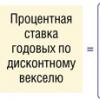Calculation of the discount rate on a bill. How to calculate interest (discount) on a bill received. Calculation of par value, purchase price and discount of a bill
After your company has issued its own bill, you need to monitor the amount of bill interest or bill discount on a monthly basis (this depends on the type of your bill). Indeed, for profit tax purposes, there are certain restrictions on accounting for interest in expenses. And these restrictions also apply to bill interest and discounts.
How to calculate interest on a bill for a month
The text of the interest-bearing bill must indicate the rate for calculating the interest that the drawer will be obliged to pay in excess of the face value when repaying the bill.
Attention
The accrual of interest ceases upon expiration of the maximum period for presenting the bill for payment.
As a general rule, interest begins to accrue on the day following the day the bill is drawn up. But if the bill itself indicates a different start date for interest accrual, then this will be the first day for interest accrual pp. 5, , 77 Regulations on bills of exchange and promissory notes, approved. Resolution of the Central Executive Committee of the USSR and the Council of People's Commissars of the USSR dated 08/07/37 No. 104/1341 (hereinafter referred to as the Regulations); Letter of the Ministry of Finance dated November 6, 2008 No. 03-03-06/2/150. An exception is a bill with a payment term “at sight, but not earlier.” If it is not specified from what date interest should be accrued, then they can be accrued from the date “not earlier than” clause 19 of the Resolution of the Plenum of the Supreme Court No. 33, Plenum of the Supreme Arbitration Court No. 14 of 12/04/2000.
Interest is accrued on the day the bill is presented for payment, but in general for no more than 365 (366) days, unless a longer period is specified in the bill itself.
If the drawer has limited the period for presenting the bill with the clause “upon sight, but not earlier,” then 365 days begin to run from the date “not earlier.”
For example, interest on a bill with a payment term “at sight, but not earlier than 03/12/2013” is accrued until 03/11/2014. If the bill is presented earlier, for example, 05/24/2013, then the last day for calculating interest is 05/24/2013.
The amount of interest accrued for the current month is calculated as follows:
- in the first month of interest accrual - from the date the interest accrual begins until the last day of the month;
- in the month of presentation of the bill for redemption - from the 1st day of the month until the day of presentation;
How to calculate the discount on a bill for a month
In order for expenses in the form of a discount (which, as we have already said, is interest on a loan) to be taken into account in the period for which they are accrued, the amount of the discount in both accounting and tax accounting must be evenly distributed throughout the entire circulation period of the bill. clause 16 PBU 15/2008; clause 18 PBU 10/99; pp. 1, 8 tbsp. 272 Tax Code of the Russian Federation.
There are two ways to distribute the discount.
METHOD 1. Proportional to the number of days for which the discount is due. The number of days for which the discount is due is the period from the day following the day the bill is drawn up until the day on which the bill must be presented for redemption (circulation period).
The number of days of circulation of a bill in a month is determined:
- in the month of issue of the bill - from the day following the day of issue of the bill until the last day of the month;
- in the month of presentation of the bill for redemption - from the 1st day of the month until the day of presentation of the bill for redemption;
- in other months - as the calendar number of days in a month.


How to take into account interest and discount on “correct” bills
Income tax
For income tax, both discount and interest on the bill are recognized as expenses within the standard clause 3 art. 43, sub. 2 p. 1 art. 265 Tax Code of the Russian Federation;. The standard represents the marginal rate for calculating interest. It can be defined:
- <или>based on the refinancing rate of the Central Bank of the Russian Federation;
- <или>based on the average rate on comparable loans.
If your company receives a lot of loans and credits, it makes sense to include criteria for the comparability of debt obligations in the accounting policy, since the marginal rate determined based on comparable liabilities is greater than the marginal rate determined based on the refinancing rate. In general, loans are comparable if:
- they were issued in the same reporting period;
- they are issued in the same currency;
- loan terms differ by no more than 20%;
- loan amounts differ by no more than 20%.
In addition, the Ministry of Finance of Russia believes that loans issued by an individual and loans issued by an organization are not considered issued on comparable terms x Letter of the Ministry of Finance dated 06/02/2010 No. 03-03-06/2/104.
The issue of comparability of bill and non-bill debt obligations is controversial. From the letters of the Ministry of Finance we can conclude that bill and non-bill debts are not comparable Letter of the Ministry of Finance dated July 21, 2010 No. 03-03-06/2/129.
FROM AUTHENTIC SOURCES

Consultant of the Department of Tax and Customs Tariff Policy of the Ministry of Finance of Russia
“ Indeed, to determine the comparability of debt obligations, you cannot use the terms of the loan agreement and the loan formalized by a bill of exchange. For the terms of obligations to be considered comparable, such obligations must be of the same type. Moreover, it is necessary that loans on identical terms be issued to two or more organizations.”
To calculate the average rate on comparable loans, you must first determine the interest rate on the bill. With an interest-bearing bill, everything is clear - its rate is indicated in the text of the bill. And for discount bills, the interest rate will need to be determined independently using the formula that we gave above. We substitute the resulting interest rate into the formula for calculating the average interest level:

The maximum amount of interest is calculated based on the average interest level increased by 1.2 times. We accept the lesser of two amounts as expenses:
- <или>this maximum interest amount;
- <или>the amount of interest actually accrued.
If you issue bills from time to time, you have not established comparability criteria in your accounting policies, or you simply do not have comparable debts, then use the rationing method at an increased refinancing rate clause 1.1 art. 269 Tax Code of the Russian Federation. Since the rate on the bill cannot change a priori, to calculate the standard we take the refinancing rate on the date of issue of the bill. Then you determine the maximum amount of discount or interest that you can take into account in expenses using the formula:
- <если>discount bill:
- <если>interest bill:
After comparing the maximum and actually accrued amounts of interest (discount) for the month, we recognize in expenses at the end of the month the amount that is less clause 8 art. 272, clause 1.1 art. 269, paragraph 8 of Art. 270 Tax Code of the Russian Federation.
Accounting
In accounting, the accrued amount of discount or interest is not standardized. The discount amount is evenly distributed over the entire circulation period of the bill. Interest and discount are recognized monthly in other expenses x clause 15 PBU 15/2008:

- before the month of presentation of the bill for repayment - on the last day of the month;
- in the month of presentation of the bill for repayment - on the date of presentation.
Accounts payable for interest or discount must be accounted for separately from the principal amount of the debt, for example, in the subaccount “Interest on a bill” to account 60 “Settlements with suppliers and contractors.” Interest should be reflected in the balance sheet in the same way as the amount of debt on a bill, that is, as borrowed funds:
- <если>the payment date on the bill does not occur within 12 months after the reporting date, then according to line 1410 “Borrowed funds” in section IV “Long-term liabilities”;
- <если>the payment date for the bill will occur within 12 months after the reporting date, and also if the payment period for the bill is set “at sight”, then according to line 1510 “Borrowed funds” in Section V “Short-term liabilities”.
In the statement of financial results, interest or discount is shown on line 2330 “Interest payable”.
How to take into account the discount on “wrong” bills
As we have already said, it is not advisable to issue a discount bill with a payment term “at sight”. And, as a rule, such bills are not issued. In practice, a discount bill is often issued with a payment term “on sight, but not earlier.” It is impossible to distribute the discount evenly on the “wrong” bill, since the payment period for it is unknown in advance. There are two ways to get out of this situation.
METHOD 1. When calculating the discount amount for a month, as well as the maximum discount amount for recognition for tax purposes, you can use in the formula, instead of the “Maturity period” indicator, the “Estimated (estimated) bill circulation period” indicator. It can be determined by the formula:
The resulting discount amount should be compared with the maximum discount amount and the lesser of these amounts should be recognized as an expense. When the bill is presented for redemption and the actual period for using the money becomes known, a recalculation will need to be made.
STEP 1. Calculate the maximum discount amount for tax purposes for the actual time of using the money.
STEP 2. Compare the total discount on the bill and the amount received in step 1.
STEP 3. From the lower amount, subtract the discount that was recognized as an expense in previous reporting periods.
STEP 4. The amount received in step 3 should be included in expenses in the reporting period when the bill is presented for redemption.
In accounting, the discount amount is evenly distributed, but not standardized. All discount not accrued at the time of presentation of the bill of exchange is recognized in other expenses on the date of presentation of the bill of exchange. clause 6 PBU 15/2008; pp. 11, 18 PBU 10/99.
METHOD 2. Do not distribute the discount between reporting periods, since interim payment of interest (discount) on the bill is not provided. The entire discount is recognized as expenses in the reporting period when the bill is presented for redemption. Art. 54, sub. 2 p. 1 art. 265 Tax Code of the Russian Federation; Resolution of the Presidium of the Supreme Arbitration Court of November 24, 2009 No. 11200/09.
In accounting, the discount is recognized in full in other expenses on the date the bill is presented for redemption. clause 15 PBU 15/2008.
We pay (repay) our own bill
Income tax
Redemption of a bill does not entail any consequences for income tax subp. 12 tbsp. 270 Tax Code of the Russian Federation.
Accounting
A bill of exchange could change many owners during its “life,” but you make payment on the bill of exchange to the person who presented it for payment. pp. 14, 16 Provisions. And in accounting it is necessary to show the repayment of the bill of exchange transferred to the supplier for goods (work, services).
Consider accounting for an “incorrect” own bill - this often causes difficulties.
Example. Accounting when issuing your own bill of exchange
/ condition / On March 15, 2013, Buratino LLC shipped oak boards worth RUB 3,300,000, including 18% VAT, for Zolotoy Klyuchik LLC. Zolotoy Klyuchik LLC issued its own promissory note in the amount of RUB 3,335,000 to secure payment on the same day. with a payment deadline “on sight, but not earlier than April 1, 2013.” The bill was presented for redemption on 04/01/2013, the money arrived in the bank account on the same day. The reporting period for income tax is a quarter.
/ decision / On the date of receipt of the bill of exchange, income and expenses for tax purposes do not arise. In the calculations we will proceed from the fact that the bill can be presented for payment at the latest on 03/31/2014. Discount 35,000 rub. (RUB 3,335,000 – RUB 3,300,000) is due to the bill holder for 381 days (16 days from 03/16/2013 to 03/31/2013 and plus 365 days). Let's calculate the discount by month:
- as of 03/31/2013 - 1469.82 rubles. (35,000 rubles / 381 days x 16 days);
- as of 04/01/2013 - RUB 33,530.18. (RUB 35,000 – RUB 1,469.82).
In tax accounting, the maximum discount amount in March will be 21,481.64 rubles. (RUB 3,300,000 x 8.25% x 1.8 / 100% / 365 days x 16 days). Since the standard has not been exceeded, the actual discount amount will be recognized in March - 1,469.82 rubles.
The maximum discount amount for the entire bill for the entire period is RUB 22,824.25. (RUB 3,300,000 x 8.25% x 1.8 / 100% / 365 days x 17 days). This is less than the total discount on the bill - 35,000 rubles, so the “missing” 21,354.43 rubles will be recognized in expenses in April. (RUB 22,824.25 – RUB 1,469.82).
The following entries will be made in the accounting records of Zolotoy Klyuchik LLC.
| Contents of operation | Dt | CT | Amount, rub. |
| As of the date of receipt of materials (03/15/2013) | |||
| Materials have been capitalized | 10 "Materials" | 60 “Settlements with suppliers and contractors”, subaccount “Settlements” | 2 796 610,17 |
| The amount of VAT on purchased materials is reflected | 19 "VAT" | 60, subaccount “Calculations” | 503 389,83 |
| VAT is accepted for deduction | 68 “Calculations for taxes and fees”, subaccount “VAT” | 19 "VAT" | 503 389,83 |
| Own bill issued | 60, subaccount “Calculations” | 3 300 000,00 | |
| On the last day of the month (03/31/2013) | |||
| Discount for March recognized | 91 “Other income and expenses”, subaccount “Other expenses” | 1 469,82 | |
| As of the note repayment date (04/01/2013) | |||
| Discount for April recognized | 91, subaccount “Other expenses” | 60, subaccount “Interest on bill of exchange” | 33 530,18 |
| PNO recognized ((RUB 33,530.18 – RUB 21,354.43) x 20%) | 99 “Profits and losses”, subaccount “PNO” | 68, subaccount “Income Tax” | 2 435,15 |
| Money transferred on a bill of exchange | 60, subaccount “Bills issued” | 51 “Current account” | 3 300 000,00 |
| 60, subaccount “Interest on bill of exchange” | 51 “Current account” | 35 000,00 | |
What to do if the payment deadline has arrived, but the bill has not been returned to you? Nothing special, do the same as with regular accounts payable: after the statute of limitations expires, write off the debt on the bill along with interest as income. clause 18 art. 250 Tax Code of the Russian Federation. In this case, the limitation period - 3 years - is counted not from the date of drawing up the bill of exchange, but from the latest date when the bill of exchange can be presented for payment pp. 70, 77 Regulations; Resolution of the Federal Antimonopoly Service of the Moscow Region dated September 5, 2011 No. KA-A40/9381-11.
A promissory note is a written obligation of a bank, possibly a company, to pay a sum of money within a certain period of time to the person specified in the promissory note. Bills of exchange are issued in paper form because they are issued in a specific name. The debt security has no restrictions on the term and amount. After repayment of the bill, income and fixed interest are paid. Nowadays, basically everyone in the market issues discount bills, which are repaid at the amount specified in the paper, but initially they pay a lower price for it - a discount.
The bill market is not as developed as the stock market, but nevertheless, investments can bring quite a large income compared to the income on bonds or on a bank deposit. It must be said that this investment will only be profitable if you are going to put into circulation at least 1 million rubles.
Pros of bills
What is the advantage of these securities? Why is it profitable to do business with them? Investors who do not expect large incomes in a short time with the likelihood of being left with nothing prefer a fixed income on the invested amounts. Their choice falls on government bonds, road certificates, and deposits. Bills of exchange are used very rarely, although they can bring good income. Typically, banks offer interest and discount bills.
Often the yield on bills is equal to the yield received on deposits or bonds. Of course, we mean reliable bills of major banks with state participation - Sberbank, Gazprombank, VTB.
Approximate mathematics
A Sberbank bill gives a yield of 5% per annum after six months, and 6% after a year. Annual deposits at the same time have a return of about 9%. Bonds of VTB and Gazprombank provide a yield of about 6% per annum. By the way, Sberbank also offers a discount bill as an income product.
Only bills with low reliability can compete with deposits and bonds of banks with state participation. But this is a big risk; here the investor himself decides whether to invest his funds in banks and financial companies or not. 
Another important point
But there is one very important advantage of a promissory note: with this debt paper you can pay, for example, for an apartment or a car, and it is also accepted as collateral when filling out a loan application.
The debt paper can be transferred to another person, or simply sold.
A sample of a discount bill, as well as other types of written bank obligations, can be viewed on the Internet.
Cons of bills
Debt securities are not very popular among private investors, because they have a number of disadvantages that are quite capable of forcing a person not to pay attention to such investments.
The main disadvantage is the amount of investment. The investor must be a very wealthy person, ready to invest at least 1 million rubles in a debt security.
Bank bills are not protected in the event of a bank failure. Knowing how often in Russia licenses are revoked even from seemingly reliable banks, people refuse to take risks by buying debt securities. Some banks continue to operate but may default on bills. In this case, the investor also does not receive money.
Individuals who have money on deposits are included in the first place as creditors in bankruptcy proceedings, and bill holders are classified as 5th priority creditors.
Non-credit institutions may also default on bills of exchange. 
Difficulties of early return
It is much more difficult to return money before the end of the term on bills of exchange than on deposits, even those concluded under the conditions that early withdrawal of funds is impossible. That is, if an investor urgently needs his money invested in a bill, he will have to sell the debt paper on the secondary market and, most likely, at a price even lower than the purchase price.
Where and how to buy a bill?
If, nevertheless, all the shortcomings of promissory notes did not stop the investor, you can find out in this part of the article how to purchase the paper and where.
Companies that want to place a bill of exchange usually entrust this procedure to banks and investment companies, which are financial agents. This also applies to simple discount bills from Sberbank, for example. The first owner of the bill is the financial agent; other market participants already buy from him. So private investors buy all the bills on the secondary market.
Although the bill has a cash equivalent, it is not traded on exchanges, so average prices can be viewed in the Russian bill of exchange system (RVS), as well as on the official websites of news agencies - Finmarket, Interfax.
Even if you like a certain bill of exchange, it is impossible to buy it yourself on the secondary market; you will need to contact a professional intermediary. Usually these are banks and investment companies (IC Veles-Capital, IC Region, for example). 
The procedure for purchasing a debt obligation is extremely simple. The investor signs a regular paper purchase and sale agreement with a financial agent or professional market participant. Pays for the transaction from his account plus interest on the transaction.
Agent commissions range from 0.3-2.5% of the transaction amount. In any case, you should have at least $100 ready. A private person can turn to the same intermediary or financial agent again if he does not want or for some reason cannot wait for the repayment of the bill. But the commission will have to be paid again in the same amount. Due to these nuances, accounting for discount bills does not seem to be something simple.
Impossibility of speculation
You won’t be able to trade bills on exchanges, so you shouldn’t expect speculative demand for them. Since each time you will have to pay a commission to intermediaries, all these operations will be unprofitable. You also need to remember about the 13% that will have to be paid to the tax authorities if the transaction is profitable. It is extremely rare for private investors to sell bills ahead of maturity.
Sberbank bills
Sberbank offers interest-bearing ruble bills and foreign currency bills. Income on them is accrued in the form of interest.
Also on sale is a discount bill, also in rubles and foreign currency. The difference between the repayment amount and the purchase amount will be the income, amount (face value) and sale price of the bill to the first bill holder. 
An interest-bearing debt obligation to bearer is issued with a predetermined maturity date and with any period, but not earlier than a certain date. This is the difference between a discount bill and an interest bill. But this is only a superficial glance. There are several more nuances.
For discount bills, the repayment system is slightly different: on a certain date or on any day, but not earlier than the date specified in the bill.
There are also convertible bills of Sberbank. The cost on the paper is stated in US dollars or euros, but it must indicate that payment will be made in rubles on the maturity date. Such a bill of exchange is also purchased for rubles.
Note to investors
Currently, bills of exchange from more than 200 companies and banks are traded on the market, many of them also offer discount bills. Specialists of the stock market and investment companies recommend that private investors invest in bank bills, since the Central Bank maintains strict financial control of all banks and forces them to disclose their financial position on official websites. Here, even the investor himself, having minimal knowledge, will be able to assess the reliability of a particular bank. 
Those at risk are always promissory notes that offer inflated interest rates and are traded by little-known companies with closed financial statements. Very often, such companies are ordinary financial pyramids. It will be extremely difficult or impossible to get the money back.
The note usually has strict maturity dates. It is advisable to receive money on this day or, at most, within the next two banking days. The discount bill is repaid exactly at par at the end of the term. Of course, no one charges any fines or additional interest; they usually accommodate the investor halfway, but they have the right not to pay an overdue bill. You can receive the money yourself, or entrust it to the financial agent or broker who executed the transaction. But you will have to pay interest again. So it is more profitable to pay off privately. By the way, Sberbank also offers a simple discount bill.
The importance of proper formatting
The Geneva Bill of Exchange Convention of 1930 established very strict rules for the execution of bills and repayment periods. If at least one of the requirements is violated, this will prevent the document from being considered a promissory note, so you need to carefully buy a promissory note on the secondary market; there are many counterfeits. Banks or bill-issuing companies have the right to refuse to cancel a bill executed with violations.
The most counterfeited bills on the secondary market are the papers of Sberbank and Gazprombank, since they are the only ones that are mainly traded on the market.
Even if an investor works in the market through an intermediary, you should not completely rely on his integrity and professionalism. In any case, you will need to request additional examination from the drawer to determine the authenticity of the paper. 
Many financial experts believe that a bill is not an investment for individuals. For those who do not agree with them, have calculated, analyzed everything and are ready to take risks, it is better to buy bills closer to the end of the quarter, half-year or year. Then the ruble supply on the market decreases, and financial agents give more favorable interest rates on repayment.
Conclusion
So, the private individual himself needs to decide whether he is ready to invest in a bill or not. Now on the market these debt securities are represented by a discount bill. That is, income is the difference between the purchase price and the repayment amount. It is advisable to repay the bill strictly on the date, otherwise payment may be refused. In order to invest profitably in bills of exchange, you must have at least 1 million rubles to complete the transaction, otherwise it will be unprofitable. On average, semi-annual bills give from 5-7% per annum. There are, of course, higher interest rates, but here the risk of losing everything is huge. Even if you decide to invest money in a bill, you will not be able to buy it on your own; you will need an intermediary - a broker, banks, investment companies. When completing a transaction, they charge a commission of 0.3-2.1% depending on the transaction amount and the drawer. It is better to buy bills from banks, because the Central Bank has a strict policy, and the financial results of any bank can be viewed on its official website and a purchase decision can be made.
Putting any security into circulation has the ultimate goal of making a profit. The final amount depends on many factors. If you have knowledge, you can independently calculate the profitability of a bill using the calculation formula.
Basic Concepts
First of all, it is necessary to understand the definitions that are used when conducting transactions with bills of exchange. First, the bill itself. This name is used in relation to a written monetary obligation of the person who provided this security (the drawer) to pay the debt to the creditor (the drawer) in the future.
A third party, the acceptor, may also participate in the process of demanding a refund within a specified period of time. This is the person (or organization) who undertakes to make payment on the presented bill.
The financial system uses the following types of bills:
- Simple and transferable. They differ in the number of participants in the transaction.
- Commodity and treasury. These bills are graded depending on the nature of the transaction.
- Bronze and counter. They differ in the possibility of provision.
- Bearer and order. The basis of their differences lies in the method of transmission.
The bill is designed to bring income to its owner, which in this case can be of two types:
- Interest that is supposed to accrue on the bill amount.
- Discount. This is the name given to the monetary difference between the amount determined on paper by the debtor himself and the one that was established upon its sale.
Discounting of a bill is the sale of a security by the holder of a bill of exchange to a credit institution before its presentation is due.
For a specific case, different types of bills can be used
Denomination of the bill
If we talk about concepts related to securities transactions, it becomes clear that not all of them can be clearly defined. Despite all the vagueness in terminology, we can only safely say that the face value of a bill is its main requisite.
This value must be written on the front side (in numbers and letters). If, for some reason, several amounts are indicated on paper at once, then the one with the smallest amount will be considered the denomination. And when this detail is missing, the bill is automatically considered void.
Provided that the bill is issued immediately, taking into account interest on the loan. Naturally, the total amount of paper will significantly depend on this fact. In this case, it is necessary to take into account that the denomination and the amount indicated on the front side will not match. But this doesn't always happen. It is not forbidden to indicate separately interest and nominal value.
When a bill of exchange is created with a discount, its denomination can be determined using the following formula:
How to determine the sale price of a bill of exchange
When paying for goods and services, citizens often do not suspect that in some cases, not only standard banknotes, but also other types of securities can be used for this purpose. For example, you can write a check or draw up a bill of exchange (naturally, in this case we are talking about a discount type).
In such situations, first of all, you always need to know how the price of a bill is determined. Naturally, if the seller is not the drawer, then it will not be possible to influence the price in any way. Therefore, before buying a paper, you should calculate how much you will be able to get for it upon redemption. To make a profit, this amount must be greater than the amount paid.
At the moment, when making calculations, it is advisable to start from the following ideas: the ratio of the interest rate and the remaining term until repayment. If it is assumed that the purchase will be carried out by a credit institution, then to calculate the rate, one should start from the average of the values that this financial enterprise uses when providing loans. All other structures can be guided by the refinancing rate (in 2018 it is equal to 7.75% per annum).
This tariff has a certain benefit for most people (we are talking primarily about sellers). After all, in a bank (for example, in VTB and Sberbank), obtaining a loan with such a percentage is available to few. If the refinancing rate is unacceptable, then it is necessary to take into account the increased rates of other banks.

When paying with a bill of exchange, it is important to know its price
But no matter what price it is offered to buy a bill of exchange, it should be taken into account that the interest on it must be equal to or higher than the profitability of the legal entity that is purchasing it.
In addition, the market price depends on the degree of potential risk. The higher it is, the higher the interest rate should be. It is worth raising it for the following reasons:
- Negative information about the drawer as an unreliable economic partner.
- The time period for presenting for repayment exceeds one year.
- The transaction price is suspiciously high.
The estimated cost will also be affected by the general situation in the country's economy. An unstable financial picture automatically increases loan interest rates.
When selling a discount bill, its price is calculated using the following formula:

For example, a bill in the amount of 1 million rubles with a circulation period of 6 months is sold at a discount of 10%
S =10000000 * (1 - 0.1 * 6)
S = 400,000 rubles.
How is the yield on a bill calculated?
Considering that there are two ways to obtain income on a bill, the methods for assessing them differ. The first is accrued interest. In this case, the formula will look like this:

In the second option, the income is the difference between the amount at redemption and the sale (or acquisition) price. In this case, the calculation is carried out as follows:

Provided that the bill is issued with the expectation that it will be in circulation for less than a year, the following formula should be applied for profitability:


It should be borne in mind that when calculating profitability using the exact percentage formula, the basis is the understanding that there are 365 days in a year. If the ordinary interest method is used, then it is assumed that there are 360 days in a year and 30 in a month.
Websites dedicated to financial topics contain a huge number of formulas that help determine profit. In some cases, it is necessary to take into account that the security may be interest-free or that when issuing a loan, the lender retains a commission. All this data must be taken into account.
In the process of calculating profit, the main thing to take into account is that the nominal value of a bill is the amount that is determined when it is issued and must be indicated on the front side. If it is not affixed, the notary has the right to protest. And this may lead to payment refusal.
The bills will be discussed in the video:
Attention! Due to recent changes in legislation, the legal information in this article may be out of date!
Our lawyer can advise you free of charge - write your question in the form below:
Free consultation with a lawyer
Request a call back
A bill of exchange can be used not only as a means of payment, but also as a way to generate income. For this purpose, you can place funds on a deposit, but it does not provide such opportunities as a bill. Bank bill is a convenient tool for placing available funds, combining profitability and the ability to use it in settlements with counterparties or as collateral. A bank bill implies that the drawer of the bill is the bank, and the holder of the bill is legal entities, individual entrepreneurs and individuals. Typically, banks offer interest and discount bills. Interest bill - a security containing an unconditional obligation of the bank to pay the bearer the amount of the bill of exchange and the income on it on the terms specified in the bill of exchange. Discount billis a security that is purchased at a price below par and is redeemed at the end of the term at par. That is, the bill of exchange is issued at a discount (discount) from the face value, and the difference between the sale price of the bill of exchange and its face value constitutes the holder’s income.

Figure 1. “Discount bill circulation scheme”
An agreement for the purchase of a bill of exchange is concluded between the bank and the client, which specifies its denomination, sale price, maturity date and other important conditions. The buyer of the bill transfers to the bank a fee for the bill (the sale price different from its face value). After receiving the funds, the bank transfers the bill of exchange to the client, which he can either keep for himself or use in settlements with counterparties. The holder of the bill uses the bill as a means of payment (at face value, not at purchased value). A bill of exchange can be replaced by several holders, the last of whom presents it to the bank for redemption. The bank redeems the bill at its face value.
Calculation of par value, purchase price and discount of a bill
Bill sale price * (1 + (bill term * rate / 365*100))
Bill sale price= Nominal value of the bill * (1 - (term of the bill * rate / 365*100))
Discount= (Bill price * interest rate * bill term) / 365 * 100
Example 1. (Determination of bill discount)
The organization purchased a bill of exchange from the bank with a face value of 20 thousand rubles. The period for presentation is 30 days. The discount rate is 10% per annum. Therefore, the discount size is determined by the formula: Discount= (Bill price * interest rate * bill term) / 365 * 100 20 thousand rubles * 10 * 30 / 365 * 100 = 164.38 rublesExample 2. (Determining the sale price of a bill of exchange)
The organization purchased a bill of exchange with a nominal value of 20 thousand rubles from the bank. The period for presentation is 30 days. The discount rate is 10% per annum. Therefore, the sale price of the bill is determined by the formula: Bill sale price= Nominal value of the bill * (1 - (term of the bill * rate / 365*100)) 20 thousand rubles * (1 - (30*10/365*100) = 19,835.62 (We check: we add a discount to the selling price, to get the face value of the bill 19,835.62 + 164.38 = 20,000)Example 3. (Determining the face value of a bill)
The organization purchased a bill of exchange from the bank at a price of 19,835.62 thousand rubles. The period for presentation is 30 days. The discount rate is 10% per annum. Therefore, the denomination of the bill is determined by the formula: Face value of the bill= Sales price of the bill * (1 + (term of the bill * rate / 365*100));9,835.62 * (1 + (30*10 / 365*100)) = 20 thousand rubles
Business loan application Your application will be sent to several banks
in your city that provide small business loans. You can select one or several banks at once.
This follows from articles 5 and 77 of the Regulations approved by the resolution of the Central Executive Committee of the USSR and the Council of People's Commissars of the USSR dated August 7, 1937 No. 104/1341, paragraph 22 PBU 19/02, paragraph 7 PBU 9/99, paragraph 11 PBU 10/99, paragraph 3 Article 43 and paragraph 4 of Article 328 of the Tax Code of the Russian Federation.
How to calculate additional income on a bill depends on the form in which this income was received:percent or discount .
Interest calculation
The calculation of interest on a bill received depends on the following indicators:
- the amount on which interest is calculated;
- interest rate on a bill;
- the duration of the period for which the calculation is made (for example, a month).
To determine the amount of interest on a bill for a month, use the formula:
This follows from paragraph 16 of PBU 9/99 and paragraph 4 of Article 328 of the Tax Code of the Russian Federation.
The amount on which interest is calculated is face value of the bill .
The rate at which interest is calculated is indicated on the bill itself. If there is no interest rate in the bill, it is considered non-interest bearing.
This procedure follows from Articles 5 and 77 of the Regulations, approved by Resolution of the Central Executive Committee of the USSR and the Council of People's Commissars of the USSR dated August 7, 1937 No. 104/1341.
- the date from which interest should begin to accrue;
The procedure for determining the date from which to begin accruing interest on a bill of exchange does not depend on whose bill of exchange was received: a third party or the counterparty’s own bill of exchange.
Start calculating interest for the month from the day following the day when the bill was received into ownership (for the month in which it was received), or from the beginning of the month (if the bill was received last month). If the bill itself specifies a later date from which interest is calculated, calculate it also from the next day.
This procedure follows from Articles 5, 73 and 77 of the Regulations, approved by the resolution of the Central Executive Committee of the USSR and the Council of People's Commissars of the USSR dated August 7, 1937 No. 104/1341, and is explained by the letter of the Department of Tax Administration of the Russian Federation for Moscow dated February 18, 2004 No. 26-08/ 10738.
The last day for interest accrual is:
- the last day of the month in accounting or taxation (if on this date the bill is the property of the organization);
- the day on which the bill must be presented for redemption (the end of the bill's circulation period);
- the day on which the period during which interest accrues ends (if it is established in the bill and does not coincide with the date of its repayment).
This follows from paragraph 16 of PBU 9/99, paragraph 4 of Article 328 of the Tax Code of the Russian Federation, Chapter V of the Regulations approved by the resolution of the Central Executive Committee of the USSR and the Council of People's Commissars of the USSR dated August 7, 1937 No. 104/1341, and paragraph 19 of the resolution of the Plenum of the Supreme Court of the Russian Federation dated 4 December 2000 No. 33 and the Plenum of the Supreme Arbitration Court of the Russian Federation of December 4, 2000 No. 14.
An example of calculating interest on a third party bill for a month
On January 12, CJSC Alpha (seller) entered into an agreement for the supply of a consignment of goods with LLC Trading Company Hermes (buyer) for a total amount of 118,000 rubles. (including VAT - 18,000 rubles). The contract provides for the buyer to pay an advance in the amount of RUB 23,600. (including VAT - 3600 rubles).
On the same day, Hermes handed over to Alfa a bill of exchange from a third party (JSCB Nadezhny) with a nominal value of 23,600 rubles as an advance payment. The bill provides for the accrual of 5 percent per annum from the date of the bill.
RUB 23,600 × 5%: 365 days. × 19 days = 61 rub.
An example of calculating interest on a counterparty's own bill for a month
On the same day, Hermes transferred its own bill of exchange with a face value of 118,000 rubles to secure payment for the goods. The bill provides for accrual of 5 percent per annum from January 20.
Alpha's accountant calculated the amount of interest on the bill for January:
118,000 rub. × 5%: 365 days. × 11 days = 178 rub.
Situation: When should the drawer accrue interest on a bill maturing “at sight, but not before...”? The early date for presentation of the bill has not arrived.
Interest on a bill of exchange for which the payment term is specified “at sight, but not earlier than...”, is calculated from the day following the day indicated as the earliest date on which the bill can be presented for payment. It is explained like this.
Bill holders calculate interest from the date of receipt of the bill or a later date indicated on it (Articles 5 and 77 of the Regulations, approved by Resolution of the Central Executive Committee and Council of People's Commissars of the USSR dated August 7, 1937 No. 104/1341).
The Supreme Arbitration Court of the Russian Federation explained this procedure as follows. Interest must be accrued after the date of drawing up (receipt) of the bill of exchange if:
- it contains a direct clause about this (i.e., the inscription “interest is calculated from such and such a date” indicating a specific date);
- the payment term for it is “on presentation, but not earlier...” indicating a specific date.
This is stated in paragraph 19 of the resolution of the Plenum of the Supreme Court of the Russian Federation dated December 4, 2000 No. 33 and the Plenum of the Supreme Arbitration Court of the Russian Federation dated December 4, 2000 No. 14.
In any of these cases, when calculating interest, do not include the day from which interest is calculated. That is, start counting the number of days from the day following one of the indicated moments. This follows from Article 73 of the Regulations, approved by Resolution of the Central Executive Committee of the USSR and the Council of People's Commissars of the USSR dated August 7, 1937 No. 104/1341.
Discount calculation
The calculation of the discount on a bill received depends on the following factors:
- the total amount of the discount (the difference between the nominal and original value of the bill);
- the number of calendar days remaining until the expiration date of the bill of exchange (i.e., until the last day when it can be presented for payment);
- the duration of the month for which the calculation is made.
To determine the discount amount on a bill for a month, use the formula:
This calculation procedure follows from paragraph 22 of PBU 19/02, paragraphs 7 and 16 of PBU 9/99, paragraph 3 of Article 43 and paragraph 4 of Article 328 of the Tax Code of the Russian Federation.
The procedure for determining the number of calendar days remaining until the end of the circulation period does not depend on whose bill of exchange was received: a third party or the counterparty’s own bill.
Determine the number of calendar days remaining until the expiration date of the bill of exchange, starting from the day following the day of receipt of the bill of exchange until the day when its circulation period ends.
This procedure follows from Chapter V and Article 77 of the Regulations, approved by Resolution of the Central Executive Committee of the USSR and the Council of People's Commissars of the USSR dated August 7, 1937 No. 104/1341.
As a rule, the end of the circulation period (the last day on which the bill can be presented for payment, or any indication of this date) is indicated on the bill itself (Articles 1 and 75 of the Regulations approved by the resolution of the Central Executive Committee of the USSR and the Council of People's Commissars of the USSR dated August 7, 1937 . No. 104/1341). For example, this could be the inscription “The bill is payable on the following date: December 24, 2010.”
To correctly determine the number of calendar days in a month during which the bill was in the ownership of the organization, you need to know:
- the date from which you need to start distributing the discount;
- the date on which accruals should stop.
Start calculating the monthly discount on a bill of exchange from the day following the day when the bill of exchange was received into ownership (for the month in which the bill of exchange was received), or the day of the beginning of the month (if the bill of exchange was received last month).
Consider the last day of discount distribution to be:
- the last day of the month in accounting or tax accounting (if on this date the bill is the property of the organization);
- the day of disposal of the bill of exchange from the organization’s property (for example, upon sale or transfer to a counterparty for debt);
- the day on which the bill must be presented for redemption (the end of the bill's circulation period).
This follows from paragraph 22 of PBU 19/02, paragraphs 7 and 16 of PBU 9/99, paragraph 3 of Article 43 and paragraph 4 of Article 328 of the Tax Code of the Russian Federation, Chapter V of the Regulations approved by Resolution of the Central Executive Committee of the USSR and the Council of People's Commissars of the USSR dated August 7, 1937 No. 104/1341.
An example of calculating the discount on a third party bill for a month
On January 12, CJSC Alpha (seller) entered into an agreement for the supply of a consignment of goods with LLC Trading Company Hermes (buyer) for a total amount of 118,000 rubles. (including VAT - 18,000 rubles). The contract provides for the buyer to pay an advance in the amount of RUB 23,600. (including VAT - 3600 rubles). On the same day, Hermes handed over to Alfa a bill of exchange from a third party (Sberbank of Russia) with a face value of 40,000 rubles as an advance payment. The payment deadline for the bill is March 31. On this day, Alpha presented the bill for redemption.
- for January: (RUB 40,000 - RUB 23,600): 78 days. × 19 days = 3995 rub.;
- for February: (RUB 40,000 - RUB 23,600): 78 days. × 28 days = 5887 rub.;
- for March: (40,000 rub. - 23,600 rub.) : 78 days. × 31 days = 6518 rub.
An example of calculating the discount on a counterparty's own bill of exchange for a month
On January 12, CJSC Alpha (seller) entered into an agreement for the supply of a consignment of goods with LLC Trading Company Hermes (buyer) for a total amount of 118,000 rubles. (including VAT - 18,000 rubles).
On the same day, Hermes, to ensure payment for the goods, handed over to Alpha its own promissory note with a face value of 140,000 rubles, issued on January 11. The payment deadline for the bill is March 31. On this day, Alpha presented the bill for redemption.
Alpha's accountant calculated the discount amount for each reporting period (month) during the entire time the bill was in the organization's ownership (from January 13 to March 31). The number of calendar days remaining until the expiration date of the bill of exchange is 78 days (19 days + 28 days + 31 days).
The discount amount on the third party bill received was:
- for January: (RUB 140,000 - RUB 118,000): 78 days. × 19 days = 5359 rub.;
- for February: (RUB 140,000 - RUB 118,000): 78 days. × 28 days = 7897 rub.;
- for March: (RUB 140,000 - RUB 118,000): 78 days. × 31 days = 8744 rub.
Situation: When calculating the discount on a bill of exchange with a payment term “at sight,” how can you determine the date when this bill ceases to be valid?
The expiration date of such a bill of exchange is the 365th (366th) day from the date of its preparation.
The debtor is obliged to pay a bill of exchange due “at sight” upon its presentation. Moreover, such a bill must be presented for payment within one year from the date of its preparation. Provided that this annual period has not been changed by the drawer or endorsers.
In this case, the bill does not have any inscriptions that shorten or extend its circulation period. Therefore, its circulation period is considered to be a calendar year - 365 or 366 calendar days - that is, all the days during which the bill can change hands or be in the ownership of any bill holder.
This procedure follows from Articles 34 and 77 of the Regulations, approved by Resolution of the Central Executive Committee of the USSR and the Council of People's Commissars of the USSR dated August 7, 1937 No. 104/1341.
Situation: How, when calculating the discount on a bill of exchange with a payment term “at sight, but not earlier than a certain date,” determine the date when this bill ceases to be valid?
The expiration date for such a bill of exchange is the 365th (366th) day from the earliest date on which the bill can be presented for payment.
The debtor is obliged to pay a bill of exchange due “at sight” upon its presentation. Such a bill must be presented for payment within one year from the date of its preparation. The drawer may establish that a bill of exchange due at sight cannot be presented for payment before a certain date. In this case, the annual period for presenting the bill is counted from the date specified by the drawer.
Moreover, during the period from the date of drawing up the bill to the earliest date when it can be presented for payment, the bill can also change hands or be in the ownership of any bill holder.
That is, the circulation period of such a bill of exchange is the period from the date of drawing up the bill of exchange to the day indicated as the earliest date on which the bill of exchange can be presented for payment, in the inscription “upon sight, but not earlier than...”, plus 365 (366) calendar days.
This procedure follows from Articles 34 and 77 of the Regulations, approved by Resolution of the Central Executive Committee of the USSR and the Council of People's Commissars of the USSR dated August 7, 1937 No. 104/1341. This point of view is also confirmed by letters of the Ministry of Finance of Russia dated November 7, 2008 No. 03-03-06/3/14, dated November 6, 2008 No. 03-03-06/2/150, dated March 6, 2008 No. 03 -03-06/2/21, dated March 30, 2007 No. 03-03-06/2/56 and dated May 18, 2006 No. 03-03-04/2/143.
Read also...
- Analysis of the ratio of income, expenses and financial results Ratio of profit and expenses
- How to calculate interest (discount) on a bill received
- Czech cuisine. We translate the Czech menu. Traditional Czech dishes Czech cooking
- Classic onion salad with boiled egg and mayonnaise How to make onion salad


















